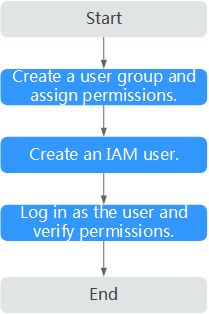Creating an IAM User and Granting SFS Turbo Permissions
This section describes how to use IAM to implement fine-grained permissions control for your SFS Turbo resources. With IAM, you can:
- Create IAM users for employees based on your enterprise's organizational structure. Each IAM user will have their own security credentials for accessing SFS Turbo resources.
- Grant users only the permissions required to perform a given task based on their job responsibilities.
If your HUAWEI ID does not require individual IAM users, skip this section.
This section describes the procedure for granting user permissions. Figure 1 shows the process flow.
Prerequisites
Before granting permissions to user groups, learn about SFS Turbo system-defined permissions. For the permissions of other services, see System Permissions.
Process Flow
- Create a user group and assign permissions to it.
Create a user group on the IAM console and assign the SFS Turbo ReadOnlyAccess permissions to the group.
- Create a user and add it to a user group.
Create a user on the IAM console and add the user to the group created in 1.
- Log in and verify permissions.
In the authorized region, perform the following operations:
- Choose Service List > Scalable File Service Turbo. On the SFS Turbo console, click Create File System in the upper right corner. If a message appears indicating that you have insufficient permissions to perform the operation, the SFS Turbo ReadOnlyAccess permissions are in effect.
- Choose another service from Service List. If a message appears indicating that you have insufficient permissions to access the service, the SFS Turbo ReadOnlyAccess permissions are in effect.
Feedback
Was this page helpful?
Provide feedbackThank you very much for your feedback. We will continue working to improve the documentation.See the reply and handling status in My Cloud VOC.
For any further questions, feel free to contact us through the chatbot.
Chatbot






